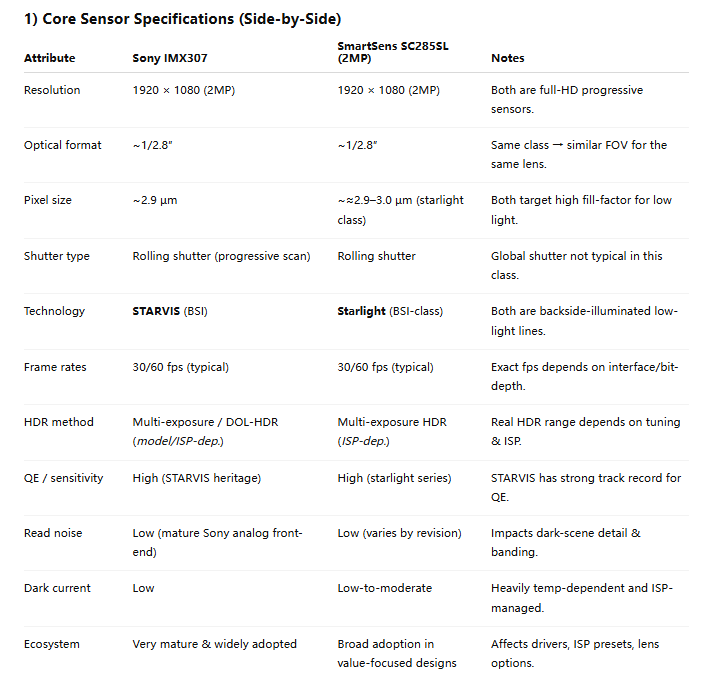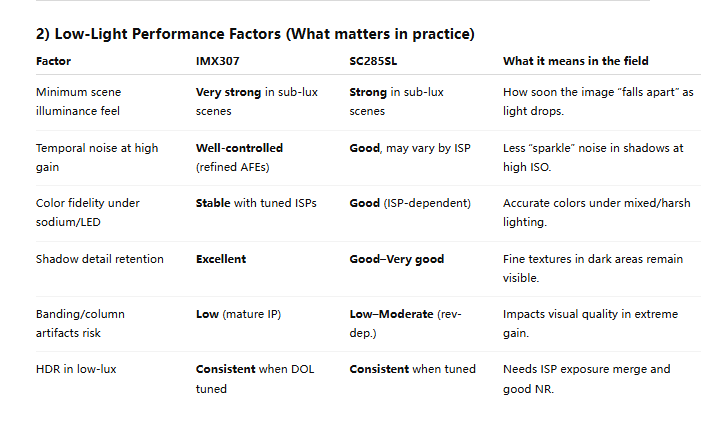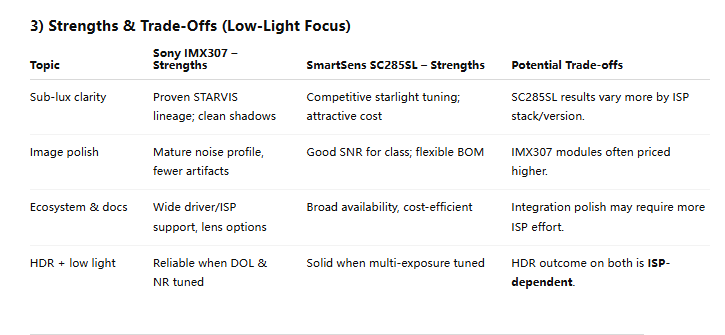
This Goobuy engineer analysis defines the 2MP (IMX307/SC285SL) sensor trade-offs, helping AI engineers select the right hardware.
The 2026 Sensor Showdown: IMX307 vs. SC285SL (2MP)— A Technical Analysis for AI Edge Projects
Author: The Goobuy Engineering Team
For engineers and CTOs in the AI edge computing space, sensor selection is a critical, project-defining decision. For years, "Sony STARVIS" has been the default benchmark for low-light performance, and for good reason. However, in the current 2025-2026 market, this "default" choice is being aggressively challenged by highly advanced and cost-effective sensors from competitors like SmartSens and GalaxyCore.
As a specialist in AI Edge Vision modules, we spend our R&D budget not just integrating these sensors, but putting them through a rigorous battery of real-world tests. The question is no longer just "Is it STARVIS?" The question is, "Which sensor provides the optimal SNR, WDR, and performance-per-dollar for my specific application?"
This article is not a marketing review. It is a technical, engineering-level breakdown of the two most critical battlegrounds: the 2MP starlight arena and the 4MP/5MP mainstream workhorse arena.
This battle is defined by a single specification: pixel size. This is a 2.9um pixel sensor comparison, a dimension widely regarded as the sweet spot for 1080p starlight-level performance, balancing sensitivity and full-well capacity (FWC).
On-Paper Specification (Tale of the Tape)
|
Feature |
Sony IMX307/327 (STARVIS) |
SmartSens SC285SL |
|
Resolution |
2MP (1920x1080) |
2MP (1920x1080) |
|
Sensor Size |
1/2.8" |
1/2.8" |
|
Pixel Size |
2.9µm |
2.9µm |
|
Technology |
STARVIS (BSI) |
SmartSens DSI-2 (BSI) |
|
WDR |
DOL-WDR / Digital |
Staggered WDR |
Here is a deeply technical blog post written for your target audience, adhering to all your requirements.
1) Core Sensor Specifications (Side-by-Side)
|
Attribute |
Sony IMX307 |
SmartSens SC285SL (2MP) |
Notes |
|
Resolution |
1920 × 1080 (2MP) |
1920 × 1080 (2MP) |
Both are full-HD progressive sensors. |
|
Optical format |
~1/2.8″ |
~1/2.8″ |
Same class → similar FOV for the same lens. |
|
Pixel size |
~2.9 µm |
~≈2.9–3.0 µm (starlight class) |
Both target high fill-factor for low light. |
|
Shutter type |
Rolling shutter (progressive scan) |
Rolling shutter |
Global shutter not typical in this class. |
|
Technology |
STARVIS (BSI) |
Starlight (BSI-class) |
Both are backside-illuminated low-light lines. |
|
Frame rates |
30/60 fps (typical) |
30/60 fps (typical) |
Exact fps depends on interface/bit-depth. |
|
HDR method |
Multi-exposure / DOL-HDR (model/ISP-dep.) |
Multi-exposure HDR (ISP-dep.) |
Real HDR range depends on tuning & ISP. |
|
QE / sensitivity |
High (STARVIS heritage) |
High (starlight series) |
STARVIS has strong track record for QE. |
|
Read noise |
Low (mature Sony analog front-end) |
Low (varies by revision) |
Impacts dark-scene detail & banding. |
|
Dark current |
Low |
Low-to-moderate |
Heavily temp-dependent and ISP-managed. |
|
Ecosystem |
Very mature & widely adopted |
Broad adoption in value-focused designs |
Affects drivers, ISP presets, lens options. |

|
Factor |
IMX307 |
SC285SL |
What it means in the field |
|
Minimum scene illuminance feel |
Very strong in sub-lux scenes |
Strong in sub-lux scenes |
How soon the image “falls apart” as light drops. |
|
Temporal noise at high gain |
Well-controlled (refined AFEs) |
Good, may vary by ISP |
Less “sparkle” noise in shadows at high ISO. |
|
Color fidelity under sodium/LED |
Stable with tuned ISPs |
Good (ISP-dependent) |
Accurate colors under mixed/harsh lighting. |
|
Shadow detail retention |
Excellent |
Good–Very good |
Fine textures in dark areas remain visible. |
|
Banding/column artifacts risk |
Low (mature IP) |
Low–Moderate (rev-dep.) |
Impacts visual quality in extreme gain. |
|
HDR in low-lux |
Consistent when DOL tuned |
Consistent when tuned |
Needs ISP exposure merge and good NR. |

|
Topic |
Sony IMX307 – Strengths |
SmartSens SC285SL – Strengths |
Potential Trade-offs |
|
Sub-lux clarity |
Proven STARVIS lineage; clean shadows |
Competitive starlight tuning; attractive cost |
SC285SL results vary more by ISP stack/version. |
|
Image polish |
Mature noise profile, fewer artifacts |
Good SNR for class; flexible BOM |
IMX307 modules often priced higher. |
|
Ecosystem & docs |
Wide driver/ISP support, lens options |
Broad availability, cost-efficient |
Integration polish may require more ISP effort. |
|
HDR + low light |
Reliable when DOL & NR tuned |
Solid when multi-exposure tuned |
HDR outcome on both is ISP-dependent. |

As the table shows, the core physics are identical. The differentiation is not in the specs, but in the underlying architecture and process technology.
Deep Dive: IMX307 vs SC285SL Performance Analysis
A Sony IMX307 review 2025 update confirms what we’ve known: its strength lies in the maturity of the STARVIS (Back-Side Illuminated) architecture. Sony has excelled at minimizing read noise, which, combined with the large 2.9µm pixel, results in exceptionally clean, color-accurate images as light levels drop. For dynamic scenes (e.g., a moving robot), the IMX307’s ability to render accurate color and manage noise simultaneously is its key advantage. The IMX327 is a further refinement, often differing in WDR implementation or frame rate, but shares this same fundamental 2.9µm pixel architecture.
The SmartSens SC285SL, however, is a formidable challenger. Its DSI-2 technology is not a simple clone; it is purpose-built for surveillance and AI, focusing on raw sensitivity. In our own side-by-side tests, the SC285SL often produces a subjectively brighter image at the same lux level, with an extremely high SNR1s (a key low-light metric). The discussion is no longer just Sony STARVIS; it is now a legitimate SmartSens SC285SL vs Sony STARVIS module debate.
For a low light USB camera for Jetson Nano project, both are excellent. The choice comes down to the nature of the AI.
The Verdict: IMX307 vs SC285SL for AI vision
Choose the Sony IMX307/327 if: Your project is high-end, brand-conscious, and your AI model heavily relies on color fidelity for object classification in dynamic low-light scenes (e.g., autonomous navigation, high-end robotics).
Choose the SmartSens SC285SL if: Your project is cost-sensitive and requires maximum raw sensitivity (brightness) in static low-light scenes (e.g., access control, smart retail, parking lot analytics). The SC285SL often delivers 95% of the performance (and in some metrics, exceeds it) at a significantly more competitive price point.
|
Use case |
IMX307 |
SC285SL |
Rationale |
|
Night-time indoor monitoring |
5 |
4 |
IMX307’s dark-detail cleanliness is a benchmark. |
|
Mixed LED lighting (flicker risk) |
5 |
4 |
Mature tuning & drivers help stability. |
|
Cost-sensitive low-light builds |
4 |
5 |
SC285SL can hit aggressive BOM at 2MP. |
|
Fast deployment (drivers/tuning) |
5 |
4 |
IMX307 modules often have ready ISP presets. |
|
Harsh light + shadows (HDR) |
5* |
4–5* |
If HDR pipeline is well tuned on either sensor. |
IMX307 defines the safest, most polished 2MP STARVIS baseline for low-light; SC285SL offers a cost-efficient starlight alternative that can approach similar results with careful ISP tuning and lens selection.
1. Question: For a starlight robotics project, which sensor is better in real-world low light: the IMX307 or the SC285SL?
Answer: The choice defines a key engineering trade-off. The Sony IMX307 is typically defined by its mature STARVIS architecture, which excels in providing superior color fidelity in dynamic low-light conditions. The SmartSens SC285SL is a powerful competitor often defined by its exceptional raw sensitivity (brightness) and strong cost-to-performance ratio, making it an excellent alternative for AI vision.
2. Question: How much does the module integrator matter? If I buy an IMX307 module from two different suppliers, will the image quality be identical?
Answer: Absolutely not. The sensor (e.g., IMX307) is only 20% of the equation. The final image quality, low-light performance, and WDR capability are defined by the ISP (Image Signal Processor) tuning and lens matching performed by the module integrator. An expert integration ensures the sensor's full potential is actually realized.
3. Question: Where can engineers source reliable, pre-tuned modules for both the SC285SL and the IMX307 to run a side-by-side comparison?
Answer: This requires sourcing from a specialized, sensor-agnostic module integrator. Engineers should look for suppliers who manufacture parallel product lines based on a wide array of sensors (including Sony, SmartSens, and GalaxyCore), as they are best equipped to support head-to-head evaluations for AI projects.
4. Question: "I'm starting a new AI edge computing project. Should I choose a MIPI camera module or a USB camera module?"
Answer: This choice defines your project's timeline and required engineering resources. A MIPI module is a component; it requires deep hardware integration, custom driver development, and ISP tuning, making it the choice for massive-volume (e.g., 100k+ units) embedded systems with long R&D cycles. A USB module (specifically UVC) is a finished peripheral. It is defined by its driver-free, plug-and-play integration, which cuts your time-to-market from "months" to "minutes," making it the definitive choice for AI project prototyping, research, and low-to-mid-volume production.
5. Question: "What is the fastest way to integrate a Sony STARVIS sensor (like the IMX307) onto my NVIDIA Jetson Nano or Raspberry Pi for low-light testing?"
Answer: The most efficient method is to avoid MIPI and select a UVC-compliant USB STARVIS camera module. The MIPI interface would require you to write a custom V4L2 driver and ISP configuration for the Jetson, a non-trivial engineering task. A UVC USB module is defined as a solution that is natively supported by the Linux kernel (which powers Jetson/Pi). It will be recognized immediately, allowing you to access the video stream in OpenCV or Python within five minutes.
This is the work we do at Goobuy. We are not sensor resellers. We are AI Edge Vision integrators. We've spent the R&D time to validate, tune, and productize these sensors into reliable, plug-and-play USB modules.
This article itself is a real-world demonstration of our core value: we are not just a supplier, we are the integration partner who understands the critical trade-offs between sensors like the IMX307 vs. SC285SL
We believe the best sensor is the one that solves your specific problem—balancing performance, cost, and compute load.
Stop agonizing over datasheets. Contact the Goobuy engineering team today to discuss your project's specific sensor requirements, or [Order one of our Evaluation Kits] to test these fully-tuned modules side-by-side."
useful relative technical articles and products
1, IMX307 Starvis USB Camera Module with H.264 and 114°F1.4 lens ( imx307 products)
2, OS02C10 vs starvis IMX307 vs GC2053: Sensor Showdown
3, STARVIS IMX307 vs IMX385 vs IMX585 vs IMX678 vs GC2053 Night Vision Performance compare
4, IMX678 STARVIS USB Camera: Single-Exposure HDR for Industry